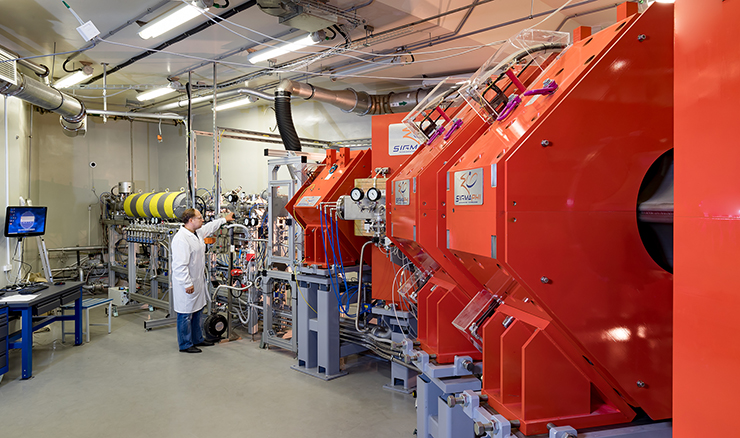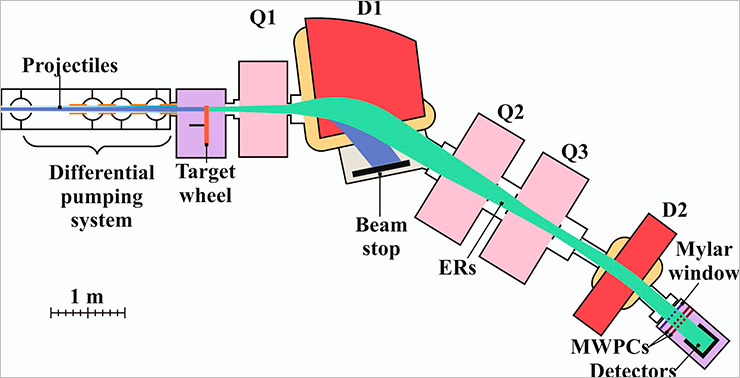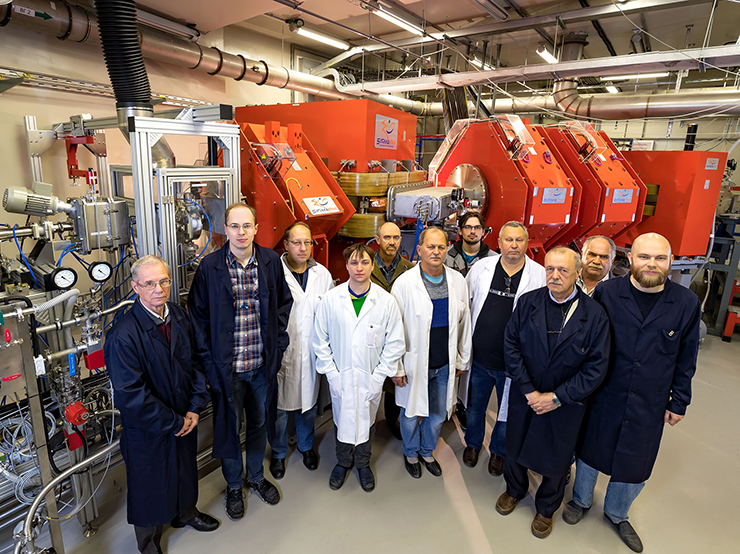Gas-filled recoil separator DGFRS-2 in FLNR JINR: tested successfully, ready for new discoveries
News, 13 September 2023
A group of scientists from JINR’s Flerov Laboratory of Nuclear Reactions was awarded the Second JINR Prize 2022 for a series of publications devoted to the design and construction of a new Dubna gas-filled recoil separator, or DGFRS-2, a first setup for the synthesis of superheavy elements and study of their properties at the Superheavy Element Factory. Using DGFRS-2, scientists are planning to reach new heights in studies of the isotopes of superheavy elements and synthesize new elements 119 and 120. These publications describe the construction of the separator units, the development of software for ion transportation from the target to the detectors, and a series of test experiments conducted in 2019–2022.
 New gas-filled separator DGFRS-2
New gas-filled separator DGFRS-2
As a result of experimental efforts at the U-400 accelerator and DGFRS that have been made since 2000, the boundaries of the region of the heaviest nuclei were substantially expanded. Six elements up to Og (atomic number 118) were discovered, and the properties of the isotopes of over 50 elements from Rf (atomic number 104) and beyond were explored. However, the new setup was not capable of producing elements with atomic number greater than 118 and synthesizing the isotopes of superheavy elements with more or fewer neutrons. The separator did not allow for a deeper understanding of the properties of nuclei and the chemical properties of heavy elements either. The sensitivity of experiments, which was considered record-breaking back in 2000, was not sufficient for further research.
“To boost the sensitivity manyfold, we had to build a novel experimental complex, Superheavy Element Factory. At the heart of the facility is the DC-280 accelerator capable of running experiments with beam intensities several times higher than those of the U-400 cyclotron. DGFRS-2 became the first setup of the Factory for the synthesis of nuclei and study of their properties, which had the efficiency of transporting nuclei to the detectors twice as high as that of DGFRS at the U-400 accelerator,” FLNR Deputy Director Andrey Popeko said.
The separator and its optical components were designed in FLNR JINR; the magnets were manufactured and delivered by SIGMAPHI (France). FLNR employees from various departments applied their expertise to design and manufacture beam line components, a differential pumping system, rotating target chambers, detector chambers, a gas renewal system, vacuum components control system, a safety system, a magnet control system, etc.
Schematically the ion-optical system of DGFRS-2 can be described as QvDhQhQvD. The Qv quadrupole focuses ions emitted from the target in the vertical direction in such a way that most of the complete fusion reaction products (evaporation residues – ERs) pass through the gap of the Dh dipole magnet. This magnet with a deflection angle of 31.5° focuses particles in the horizontal direction. The dipole separates ERs from beam particles and suppresses the bulk of other background particles (such as scattered nuclei, products of incomplete fusion, etc.). The Qh and Qv quadrupoles focus ERs on the detector at the focal plane of DGFRS-2 in the horizontal and vertical directions. The D dipole with a deflection angle of 10° additionally suppresses the background from charged particles – alpha particles, protons, etc. produced in reactions of beam ions with the gas and the DGFRS-2 walls.
 Schematic diagram of the ion-optical system of the separator
Schematic diagram of the ion-optical system of the separator
“After the separator was manufactured and delivered to the Institute, we encountered some problems during the installation: the separator had to be installed in a cave, but the cave was quite small. In addition, the main magnet alone weighed 24 tonnes! One Russian company helped us lift the separator to the required height. Their staff did it very quickly and masterly. Then, together with our French colleagues, the manufacturer of DGFRS-2, we installed the separator with an accuracy of up to a millimeter using the calculated parameters and laser instruments,” Andrey Popeko said. By the way, the gained experience working with such devices really helped us in the future: during the installation of other setups as well as in accelerator assembly and repair”.
Two programmes were developed for describing the motion of ions in the magnetic field of the separator: the first programme was written while designing the separator and the other one – later on the basis of the GEANT4 software package. The developed programmes allowed for a highly accurate description of the horizontal and vertical distributions of nuclei at various combinations of currents in the magnets and at gas pressure variations in the separator, as well as the calculation of ion transmission, and the determination of current values in different experiments.
Novel boxes were developed for accomodating detectors of various sizes. The increased magnet dispersion provided significantly higher background suppression but required an increase in the size of the detecting system up to 220 cm (horizontal). Thus two double-sided silicon strip detectors (DSSD) covering an area of 48×128 mm2, each having 1-mm-wide strips on the front and back sides, were used as the focal plane stop detectors. The stop detectors are surrounded by eight side detectors with an active area of 60×120 mm2 for registering additionally alpha particles and fission fragments escaping from the stop detectors. The 120-mm-deep assembly resembles a parallelepiped with five edges. The detector system of the separator comprises multiwire proportional chambers operating at a pressure of 1.6 mbar whose signals make it possible to distinguish events caused by the arrival of a particle passing through the separator. The detection system is composed of digital and analog electronics operating independently and allowing for the ‘beam-off’ mode after the decay of the mother nucleus for suppressing background reaction products while observing the decay of daughter nuclei.
Furthermore, a gas renewal system was developed, keeping the gas pressure constant at pre-set varying rates and ensuring the safe use of different gases. Prior to experiments on the synthesis of superheavy nuclei, researchers conducted a series of test experiments. The DGFRS-2 dispersion was measured; it affects the fine tuning of dipole magnets in experiments on the synthesis of superheavy nuclei. The value was in agreement with the calculations. Additionally was defined the optimal gas pressure in the separator, essentially affecting the separator transmission. The efficiency of collecting nuclei at the DGFRS-2 detectors was measured. The efficiency of the new separator was checked in the 243Am+48Ca reaction, leading to the production of Mc (element 115) isotopes, and was found to be twice as high as that of DGFRS. Finally, the researchers examined background conditions at the new separator. DGFRS-2 provided by more than two orders of magnitude lower background compared to its predecessor, DGFRS.
 Staff members of Sector 1, FLNR, who conducted experiments at the new separator
Staff members of Sector 1, FLNR, who conducted experiments at the new separator
“The entire series of test experiments, as well as first experiments aimed at studying the isotopes of elements 110, 112, 114, and 115, showed that the new experimental complex enables researchers to further study superheavy nuclei at a considerably higher sensitivity level. Synthesis of heavier elements 119 and 120 is planned, too. Preparations are underway. For instance, by currently implementing the joint programme with Rosatom, we are getting even closer to synthesizing the new elements,” Andrey Popeko concluded.
List of publications:
- A.G. Popeko. On-line separators for the Dubna superheavy element factory.Nucl. Instrum. Methods Phys. Res. B 376, 144–149 (2016).
- Yu.Ts. Oganessian, V.K. Utyonkov, A.G. Popeko, D.I. Solovyev, F.Sh. Abdullin, S.N. Dmitriev, D. Ibadullayev, M.G. Itkis, N.D. Kovrizhnykh, D.A. Kuznetsov, O.V. Petrushkin, A.V. Podshibiakin, A.N. Polyakov, R.N. Sagaidak, L. Schlattauer, I.V. Shirokovsky, V.D. Shubin, M.V. Shumeiko, Yu.S. Tsyganov, A.A. Voinov, V.G. Subbotin, V.V. Bekhterev, N.A. Belykh, O.A. Chernyshev, K.B. Gikal, G.N. Ivanov, A.V. Khalkin, V.V. Konstantinov, N.F. Osipov, S.V. Paschenko, A.A. Protasov, V.A. Semin, V.V. Sorokoumov, K.P. Sychev, V.A. Verevochkin, B.I. Yakovlev, S. Antoine, W. Beeckman, P. Jehanno, M.I. Yavor, A.P. Shcherbakov, K.P. Rykaczewski, T.T. King, J.B. Roberto, N.T. Brewer, R.K. Grzywacz, Z.G. Gan, Z.Y. Zhang, M.H. Huang, H.B. Yang. DGFRS-2 – A gas-filled recoil separator for the Dubna Super Heavy Element Factory. Nucl. Instrum. Methods Phys. Res. A 1033, 166640 (2022).
- D.I. Solovyev and N.D. Kovrizhnykh. Simulations of recoil trajectories in Dubna Gas-Filled Recoil Separator 2 by GEANT4 toolkit. J. Instrum. 17, P07033 (2022).
- D. I. Solovyev, N. D. Kovrizhnykh, V. K. Utyonkov, Yu. Ts. Oganessian, F. Sh. Abdullin, A. A. Voinov, S. N. Dmitriev, D. Ibadullayev, M. G. Itkis, D. A. Kuznetsov, O. V. Petrushkin, A.V. Podshibiakin, A. N. Polyakov, A. G. Popeko, R. N. Sagaidak, L. Schlattauer, V. D. Shubin, M. V. Shumeiko, Yu. S. Tsyganov. Calculation and experimental characteristics of a new DGFRS-2 gas-filled separator. Report at the 72th International Conference “Nucleus2022: Fundamental problems and applications”. RAS Bulletin. Physical series (passed for the press).